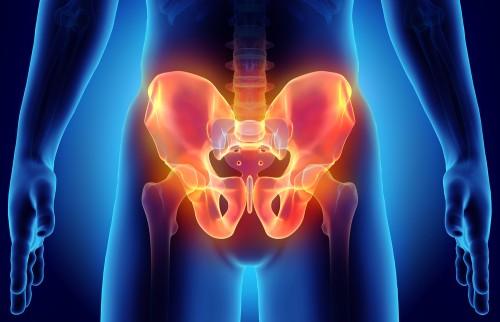This article will review how prostatitis can cause or contribute to chronic pelvic pain and what pelvic floor therapy can do to help alleviate it.
The Condition
Chronic nonbacterial prostatitis is sometimes described as a “headache in the pelvis” with pain symptoms affecting urinary and sexual function. It’s a tricky condition because as “nonbacterial” suggests, the pain and inflammation is not tied to a known bacterial infection, which can confuse both the patient as well as their healthcare providers. Yet, the pain is real and their negative affects on quality of life are real as well. The pain caused by nonbacterial prostatitis can be disabling, preventing participation in valued activities and causing isolation and depression.
Prevalence
According to Harvard Medical School, prostatitis accounts for about 1.8 million visits to the doctor’s office in the United States each year. Between 9% to 16% of men of all ages experience prostatitis.
About 90% of these instances cannot be tied to an active bacterial infection. Prostatitis affects men of all ages, unlike benign prostatic hyperplasia (BPH) and prostate cancer, which predominantly affect older men.
Causes
Possible causes of nonbacterial prostatitis include:
- Pelvic floor muscle problem
- Stress
- A past bacterial prostatitis infection
- Activities which put pressure on the pelvic floor such as bicycle riding
- Less common types of bacteria which are hard to test for
- Irritation caused by a backup of urine flowing into the prostate
- Irritation from irritants and other chemicals in the body
- Nerve problem involving the lower urinary tract
- Parasites
- Sexual abuse
- Viruses
Symptoms
- Low back pain
- Pain in genital area
- Urinary frequency (often at night)
- Urinary urgency
- Burning or painful urination
- Burning or painful ejaculation
- Pain in the genital area and lower
- Pain with bowel movements
- Pain with ejaculation
- Problems with urinating
Diagnosis
Diagnosis is made by a medical doctor. In many cases, the physical exam reveals swelling or tenderness of the prostate.
Urine cultures may show no bacteria present. Urine tests may or may not show white or red blood cells in the urine. A semen culture may or may not show a higher number of white blood cells and low sperm count with poor movement.
Treatment
Treatment for nonbacterial prostatitis is difficult as there is has been limited research regarding interventions. However, here is a roundup of the treatments that have shown to have some benefit, including pelvic floor therapy.
- Medication and the “three A’s”
Traditional drug intervention for chronic nonbacterial prostatitis/chronic pelvic pain syndrome includes antibiotics, anti-inflammatory medications, and alpha blockers. However, the use of antibiotics remains controversial. Read more about this over at Harvard Medical School. Sometimes, muscle relaxers like diazepam or cyclobenzaprine can help to reduce spasms in the pelvic floor. - Pelvic Floor Therapy as a treatment for pelvic pain
Pelvic floor therapy at Fusion Wellness and Physical Therapy can help manage the pain associated with prostatitis, helping to restore quality of life, sexual function, and empower those with prostatitis with the tools they need to help manage symptoms in the long run.
Pelvic floor therapy has been shown to help manage the symptoms of chronic pelvic pain by helping manage pain through the following modalities:
- Myofascial trigger release, The Journal of Urology published two studies (Anderson, Wise, Sawyer, and Chan (2005); FitzGerald, Anderson, Potts, et al. (2009)) on the use of myofascial trigger release in the management of chronic pelvic pain . Participants were randomly assigned to receive weekly sessions of either traditional massage or myofascial therapy for 10 weeks. 57% of those who received myofascial therapy reported that they were “markedly improved” or “moderately improved” versus just 21% in the group that received ordinary massage.
- Biofeedback downtrains tight pelvic floor muscles and can help correct dysfunctional voiding problems that may be present.
- Training in self treatment techniques including therawand, foam rolling, lymphatic massage, autonomic relaxation, and stress reduction techniques
- Visceral mobilization (gentle massage techniques that loosen internal adhesions and restore movement to the organs including the intestine, bladder, and prostate)
- Postural training and therapeutic exercise to treat dysfunctional movement
- Pelvic floor therapy to treat painful urination, painful ejaculation, pain with bowel movements, and sensitive tissues
- Exercises for pelvic muscles to lower pain, improve bladder retention, improve bowel function, and increase the flow of blood to the area
- Therapeutic yoga to improve lymphatic drainage and reduce chronic pain
- Neuromuscular re-education and autogenic relaxation to reduce chronic muscle over-activity, reduce pain, and improve sleep
Are you in pain? Here’s what you can do today.
- Take a warm bath to ease some of the pain and tension in the pelvic floor
- Deep breathing and pelvic floor relaxation exercises
- Dietary changes to avoid bladder and urinary tract irritants
- Call us at Fusion Wellness and Phyiscal Therapy, or another local pelvic floor therapist
Resources
Anderson RU, Wise D, Sawyer T, Chan C. (2005). Integration of Myofascial Trigger Point Release and Paradoxical Relaxation Training Treatment of Chronic Pelvic Pain in Men. Journal of Urology;174:155–60. PMID: 15947608.
FitzGerald MP, Anderson RU, Potts J, et al. (2009). Randomized Multicenter Feasibility Trial of Myofascial Physical Therapy for the Treatment of Urological Chronic Pelvic Pain Syndromes. Journal of Urology;182:570–80. PMID: 19535099.
O’Leary, M. (2011). Treating prostatitis: Any cause for optimism?. Harvard Medical School Health Publications: Prostate Knowledge. Accessed at: https://www.harvardprostateknowledge.org/treating-prostatitis-any-cause-for-optimism

